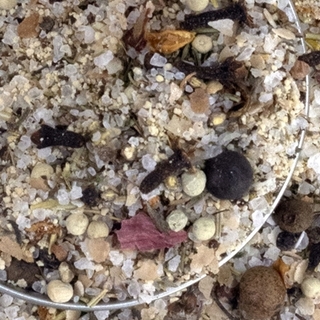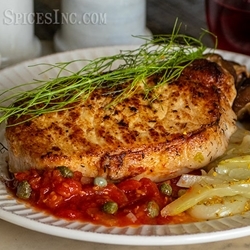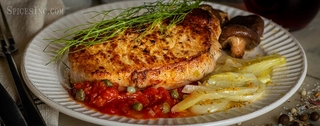Pork Chop Brine
Pork Chop Brine
Pork Chop Brine is a salty, aromatic, MSG-free brining blend. It is also called pork brine, brine for pork, pork soak, pork marinade, pork chop seasoning or pulled pork brine, wet pork chop brine, pork chop brining blend, savory pork chop brine, or brining seasoning.
Brining is a terrific way to infuse meat with flavor. This brine has salt in it, of course, which helps the meat become more receptive to other flavoring agents. Then we back it up with plenty of herbs, honey, and aromatics so you can easily build a delicious pork chop.
Businesses that frequently purchase Pork Chop Brine are:
- farmers markets;
- caterers;
- independent spice shops; and
- seasoning companies
Flavor Profile
Pork Chop Brine is salty and smoky, with woodsy bursts and a terrific aromatic lift.
How To Use
Our basic recipe is designed to season 4 pork chops that weigh roughly 6 ounces per chop.
Add 4 Tablespoons of Pork Chop Brine to two cups of brining liquid; you can use all water, or a combination of water and vegetable or chicken stock. Bring this to a boil, then remove from heat and allow to completely cool. When cool, place your pork chops in a single layer into a large container, like a pot or a non-reactive mixing bowl or baking dish. Pour the brine over the pork chops and move them to the refrigerator, or in a cooler loaded with ice. The pork chops should sit in the brine for 3-4 hours.
When you are ready to cook your chops, remove them from the brine and pat them dry before cooking as you normally would in a pan or in the oven. Visit our recipe for Brined Pork Chops with Poached Fennel to see how we use this ingredient.
| Also Called | Pork brine, brine for pork, pork soak, pork marinade, pork chop seasoning or pulled pork brine, wet pork chop brine, pork chop brining blend, savory pork chop brine, or brining seasoning |
| Species | Capsicum annuum |
| Ingredients | Sea salt, applewood smoked salt, honey (cane sugar and honey), smoked pepper, shallots, thyme, white pepper, allspice, rosemary, and cloves |
| Flavor Profile | Salty, smoky, woodsy, aromatic |
| Recommended Uses | Pork chops, tenderloin, ribs, or beef short ribs |
| Cuisine | American |
| How To Store | Airtight container in a cool, dark place |
| Shelf Life | 6-12 months |
| Country of Origin | USA |



